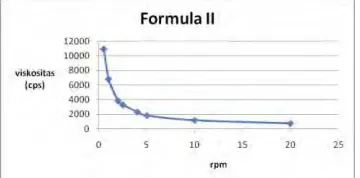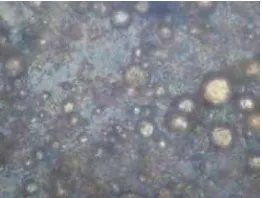CI.7 - 1
ARTICLES BALI INTERNATIONAL SEMINAR ON SCIENCE AND TECHNOLOGY 2011
g Basic Sciences and Technology for Industrial
July 22-23 , 2011, BALI-INDONESIA
ISBN 978 979-98623-1-0
FORMULATION AND PHYSICOCHEMICAL STABILITY OF
20% GLYCOLIC ACID CREAMS
USING POLYACRYLAMIDE, C13-14 ISOPARAFFIN, LAURETH-7
AND
COMBINATION OF POLYACRYLAMIDE, C13-14 ISOPARAFFIN,
LAURETH7 WITH A GLUKOLIPID OF VEGETABLE ORIGIN
Ni Luh Dewi Aryani, Nani Parfati, Rica Marlia Swandayani, dan Angelina Haliem Faculty of Pharmacy, Surabaya University
Surabaya, Jawa Timur Indonesia Email: [email protected]
Abstract
Glycolic acid is a α -hydroxy acids (AHAs). It are used in skin lightening creams. It were developed formulation of 20% glycolic acid creams. The creams were made using 4% of polyacrylamide, C13-14 isoparaffin, laureth-7 as a thickening agent for cream gels and emulsions base and combination of 1.5% of polyacrylamide, C13-14 isoparaffin, laureth-7 and 5% of a glukolipid of vegetable origin as emulisufier agent. Then the physicochemical stabilities were tested using climatic chamber for 30 days at 40oC with 75% Relative Humidity (RH). The parameters stability observed were organoleptic, droplet size, density, viscosity, emulsion type, phase separation, pH and concentration of acid glikolat.Organoleptis, droplet size, density, viscosity, type of emulsion and phase separation of all of creams were stable, but the pH decreased during the storage time. The time of the concentration of glycolic acid remaining to 90% in cream using using 4% of polyacrylamide, C13-14 isoparaffin, laureth-7 and using combination of using 4% of polyacrylamide, C13-14 isoparaffin, laureth-7 with 5% of a glukolipid of vegetable origin were 30 and 32 days respectively.
Keywords: glycolic acid, cream, physicochemical stability
1. INTRODUCTION
Healthy skin is skin that enough moisture and oil production with no damage or skin disease. Environmental, hormones, age, diet and the presence of hereditary factors can make the skin does not wrinkles, fine lines or spots on the face. The dead skin can be remove by chemical peeling treatment (Wasitaatmadja, 1997).
The materials used for chemical peeling is Alpha Hydroxy Acid (AHA). Alpha Hydroxy Acid (AHA) has other advantages compared with other active ingredients. It can increase collagen content in order to rejuvenate and moisturize the skin. One of AHAs that is used for cosmetics is glycolic acid. This ingredient works by slough off the outer skin cells. After peeling, the outermost skin cells be replaced by new skin cells naturally. The result is that the skin more fresh and looks brighter (Pollick,2003)
AHA product in the market has a concentration of about 10% or be less than 10%. Concentration on the beauty clinic is between 20-30%,
and the supervision of physicians is between 40-70% (FDA, 1998).The products should be stable at the time periode which is determined (Mitsui, 1996), as well as cosmetic products. Because stability is one of the requirement for the pharmaceutical products beside of safe, effective and acceptable (USP XXVIII, 2005). Stability of the products is include chemical, physical, microbiologycal , pharmacologycal and toxicologycal stability (USP XXVIII, 2005).
There are two ways of testing the stability, ie stability testing at room temperature (long-term testing) and an accelerated stability testing (accelerated testing) (Agoes, 2001). Method of stability testing at room temperature takes a long time (about 1 year or more) (Martin, 1993). The stability test is used to obtain information about the stability of pharmaceutical products in order to determine shelf-life and period of use in certain packaging and storage conditions.
CI.7 - 2
ARTICLES BALI INTERNATIONAL SEMINAR ON SCIENCE AND TECHNOLOGY 2011
g Basic Sciences and Technology for Industrial
July 22-23 , 2011, BALI-INDONESIA
ISBN 978 979-98623-1-0
isoparaffin, laureth-7 with 5% of a glukolipid of vegetable origin as emulisufier agent. The accelerated testing was observed by using a climatic chamber at 40° C and 75% in relative humidity (RH) within 30 days.The stability parameters were organoleptics (shape, odor, color), density, viscosity and flow properties, phase separation, droplet size emulsion type, pH, and concentration of glycolic acid.
2. METHODOLOGY
2.1. CREAM FORMULATION
The creams containing glycolic acid using polyacrylamide, C13-14 isoparaffin, laureth-7 (Formula I) and the combination of polyacrylamide, C13-14 isoparaffin, laureth-7 with a glukolipid of vegetable(Formula II) as follows:
Materials
Glycerylstearate 4,5 4,5
Stearic acid 1,5 1,5
isoparaffin, laureth-7 4 1,5
A Glukolipid of Vegetable
Origin - 5
demineralized water until 100 100
The creams were made as follows:
The glycolic acid cream using Sepigel * 305 (Formula I) as follwos: stearic acid, glyceryl monostearate and liquid paraffin are melted in a porcelain dish at temperature of 70 º C. Then it poured into a hot mortar containing Polyacrylamide, C13-14 isoparaffin, laureth-7 and stir until it forms a base of cream and homogen.Gliserin added to the base cream that has formed little by little, stirring until homogen.Natrium metabisulfite dissolved in 3 ml demineralized water until dissolved and then added to the cream and glycerin bases mixture, stirring until homogen.Propil and methyl parabens were dissolved in propylene
glycol and glycolic acid was added. Then it were stirred until homogeneous and then added to the a mixture of cream base stirring until homogen. The remaining water were added after adding the oil phase gradually, stirring until homogen. The cream was stored in tightly sealed containers and protected against the light.
The glycolic acid cream that uses a combination of Polyacrylamide, C13-14 isoparaffin, laureth-7 with a glukolipid of vegetable origin (Formula II) were made as follows: stearic acid, glyceryl monostearate, a glukolipid of vegetable origin and liquid paraffin are melted in a porcelain dish at a temperature of 70 º C. Then it were poured into a hot mortar containing Polyacrylamide, C13-14 isoparaffin, laureth-7 and stirred until it forms a base of cream and properties of the creams were tested.The organoleptics were tested by using visual, the flow properties and viscosities were tested by using Cone and plate viscometer series AT 71 362 (Brookfield), the droplet size were tested by using optical microscope, the type of emulsions were tested by using photo microscope (Zeiss Axioskop). The density were tested by using picnometer and analytical balance (sartorius). The pH were tested by using pH meter (CyberScan type 510), and the concentration of glycolic acid contained in the cream was determined using acid-base titration method.
3. RESULTS AND DISSCUSION
Organoleptics of the creams Formula I and Formula II over the 30 days did not showed the changes of the shape, odor and color. The cream is an odorless and white cream. The creams did not show separated phase for 30 days also.
CI.7 - 3
ARTICLES BALI INTERNATIONAL SEMINAR ON SCIENCE AND TECHNOLOGY 2011
g Basic Sciences and Technology for Industrial
July 22-23 , 2011, BALI-INDONESIA
ISBN 978 979-98623-1-0
Figure 2. Form of 20% glycolic acid cream Formula II
The droplet size of the cream from day 0 to day 30 can be seen in table 1. It were showed that the droplet size of formula I and formula II from day 0 to day 30 were not significantly different, but the droplet size between Formula I and Formula II significantly different
Table 1. Droplet size of 20% glycolic acid cream
The density of the cream from day 0 to day 30 can be seen in table 2. It were showed that the density of formula I and formula II from day 0 to day 30 were not significantly different, but the density between Formula I and Formula II significantly different.
The viscosity of the crems from 0 to 30 days were tested by using a Brookfield Cone and Plate viscometer AT series 71 362, with spindle CPE 41, and at a speed of 0.5 rpm can be seen in table 3. It were showed that the viscosity of formula I and formula II from day 0 to day 30 were not significantly different, but the viscosity between Formula I and Formula II significantly different
Table 2. Density of 20% glycolic acid creams
Table 3. The Viscosity of the 20% glycolic acid creams
Time (days) Formula I
(cps)
Formula II
(cps)
0 25750 10965,7
5 25240 24080
10 29616,67 20380
15 24163,33 21516,7
20 21829 24270
25 24000 21313,3
30 23606,67 22573,3
Based on observation, flow properties of both types of preparations are pseudoplastis, the higher of the rate of shear (rpm), the lower the viscosity, as see as figure 3 and 4. Because of the addition of rate of shear, the molecules that had been irregularly arrange themselves to form a straight line so that the barriers to flow into the smaller (Martin, 1993).
Figure 3. The flow properties of the 20% glycolic acid creams formula I
Figure 4. The flow properties of the 20% glycolic acid creams formula II
The emulsion type of cream were tested by using dye of methylen blue. It were showed that the emulsion type of formula I and II were oil in water emulsion ( O/W emulsion) as seen as in figure 5 and 6.
CI.7 - 4
ARTICLES BALI INTERNATIONAL SEMINAR ON SCIENCE AND TECHNOLOGY 2011
g Basic Sciences and Technology for Industrial
July 22-23 , 2011, BALI-INDONESIA
ISBN 978 979-98623-1-0
Figure 5. The o/w emulsion type of cream formula I
Figure 6. The o/w emulsion type of cream formula II The pH of the cream from 0 up to 35 days using a pH-meter CyberScan 510 can be seen in table 4. and. The pH of the creams decreased at the storage time periode. The pH between Formula I and Formula II are significant differences.
The results of determination of concentration of glycolic acid in the creams for Formula I and Formula can be seen in Table 5.
Figure 7. Log Concentrtion of glycolic acid (Ct) for 15 to 35 days (Formula I) concentration remaining of glicolic acid in the formula I and II showed that stated that concentration of glycolic acid has a linear correlation with respect to time. From the above equation is obtained that the constant rate reaction of formula I and II were k = 0.0035 day-1 and k = 0.0032 day-1 respectively. The half life of of formula I and II were 198 days and 216 days respectively. The time of the concentration of glycolic acid remaining to 90% formula I and II were 30 and 32 days respectively.
4. CONCLUSION
CI.7 - 5
ARTICLES BALI INTERNATIONAL SEMINAR ON SCIENCE AND TECHNOLOGY 2011
g Basic Sciences and Technology for Industrial
July 22-23 , 2011, BALI-INDONESIA
ISBN 978 979-98623-1-0
5. REFERENCE


